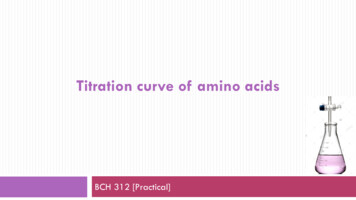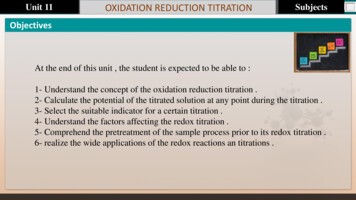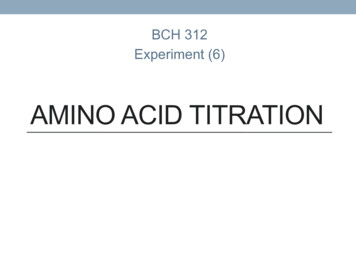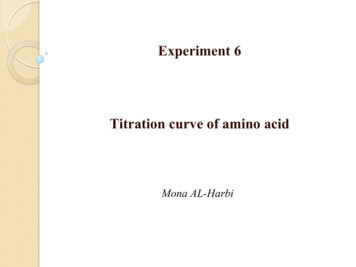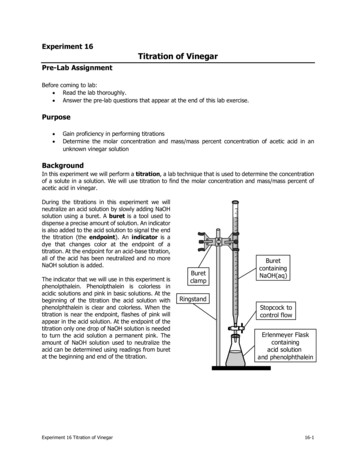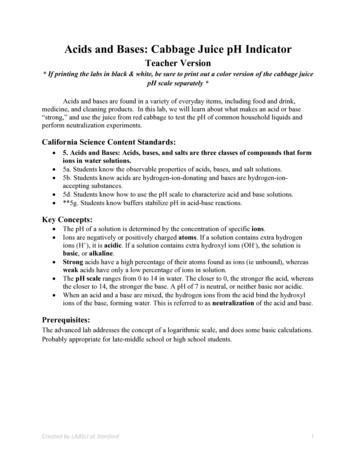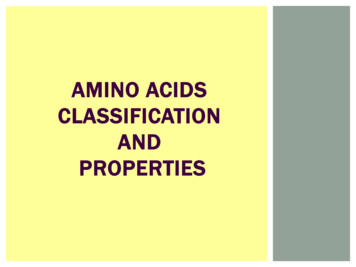
Transcription
Titration of weak acids
Methods To Prepare Buffer solutions
Titration of amino acids Amino acids are weak polyprotic acids . Neutral amino acids are (gly, ala, threonine ) are treated as diprotic acids . acidic amino acids (glu, asp,) are treated as triprotic acids . Basic amino acids (lys , arg , his ) are treated as triprotic acids . pHm is the pH at which the maximum total number of charges present. Glycine can be obtained in three forms :a) Glycine hydrochlorideb) Isoelectric glycinec)Sodium glycinate
Titration of amino acids Example: Calculate the pH of a 0.1M solution of a) Glycine hydrochloride , b) Isoelectric glycine , c)Sodium glycinateKa1 4.57 x 10-3a)Ka1Glycine hydrochloride is a diprotic acid , the carboxylic group is a much stronger acid than the amino group , the pH of thesolution is dependent exclusively by the extent the carboxyl group ionizes . [AA ] [H ], assume y [ AA 1] that ionizes .[ AA 1]Thus, y [H ] produced, and y [AA ] produced .AA 1 remaining at equilibrium [ AA 1] original - [ AA 1] that ionizes 0.1 – yThus, Ka1 (y)(y) 4.57 x 10-30.1 y
Titration of amino acidsSince amount of y (value of y) is stronger than that can be ignored ,Thus 4.57 x 10-4 - 4.57 x 10-3 y y 2y 2 4.57 x 10-3 y - 4.57 x 10-4 0.0Y 𝑏 𝑏2 4𝑎𝑐2𝑎, where a 1 , b 4.57 x 10-3 , c 4.57 x 10-4Thus y [H ] 1.92 x 10-2 .pH 1.72 .What is the degree of ionization of glycine hydrochloride in this 0.1M solution ?b) The pH of AA is the pI ( the pI is defined as that pH where the predominant ionic form is AA , so net charge on the amivoacid is zero .)pK pKa22.34 9.6So pH a1 5.9722c)Sodium glycinate is a diprotic base ,Both the unionized amino group and the carboxylate ion can accept a proton from water , but since the amino group isa much stronger base than the α-carboxylate group , the pH of the solution depends almost exclusively on theextent to which amino group ionizes .
Titration of amino acidsFor the amino group :𝐾w10 14Kb1 9.6 3.98 x10-5Ka2 10For carboxylate group ;𝐾w10 14Kb2 2.34 2.19 x10-12Ka1 10Kb1 [OH- ] [AA ] (y) (y)(y) (y)[OH ] [AA ]Kb1 [ AA 1]0.1 – ( y )Because the concentration of sodium glycinate is much larger than Kb1 thus y can be neglected from the dominator .
Titration of amino acids3.98x10-5y2 , so y2 3.98 x 10-60.1y 3.98 x 10 6y 1.99 x 10-3 M , [OH-] 1.99 x 10-3 M[H ] 𝐾w[OH ] 1 x 10 14 5 x 10-12 M1.99 x 10 3pH -log[H ] 11.3 .
Titration Curve of Neutral Amino Acids Amino acids are titrated in exactly the same manner as diprotic and triprotic weak acids .Neutral amino acid
Titration Curve of Acidic amino Acid (Glutamate )
Titration Curves of Lysine
Titration Curves of Amino AcidsInformation that can be obtained from a titration curve :1- The number of ionizable groups in that amino acid , which can be detected from the number of titration stages in the curve ,(or the number of pKa ‘s or number of flat zones in the curve) .2-Whether the triprotic amino acid is basic or acidic , that can be detected from the pKa2 .If it’s value is closer to the value of pKa1 (that of the α- carboxyl group ), then it is an acidic amino acid .If the value of it’s pKa2 is closer to the value of pKa3 (that of the α- aminogroup ), then it is basic amino acid .3- The pKa values of the amino acid can be obtained from the curve which is equal to the pH value at the mid-point .4- The isoelectric point , pI for each amino acid can be obtained from the curve by detecting the point where the amino acid is allin the zwitterion form (net charge 0.0) the pH at that point is the pI .Or it can be obtained mathematically from ;pI pKa1 pKa2( in the case of a neutral amino acid ) .2In the case of triprotic amino acids , the pI is calculated from :pI pKa1 pKa22( in the case of acidic amino acids ) .
Titration Curves of Amino AcidspI pKa2 pKa3in the case of basic amino acids.25- You can also determine from the curve the pH values at which the amino acid can act as a buffer . (the pH ranges 1 from thepH value of each midpoint).
How to Obtain a Titration Curves of Amino AcidsNo of moles of weak acid or a.aCalculate the first moles of OH by A 𝑛𝑜 𝑜𝑓 𝑚𝑜𝑙𝑒 𝑜𝑓 𝑎𝑐𝑖𝑑 𝑜𝑟 𝑎.𝑎𝑃𝐾𝑎1Calculate the second moles of OH added B No of moles of weak acid or a.a ACalculate the third moles of OH added C No of moles of weak acid or a.a B
How to Obtain a Titration Curves of Amino AcidsSketch the pH curve for the titration of 100ml of 0.1M Glycine with KOH? Pka1 1.71,Pka2 9.6?No of moles of a.a M*V 0.1 * 0.1 0.01 moleThe first moles of OH by A 0.01 / 1.71 0.005The second moles of OH added B 0.01 0.005 0.015PI (Pka1 pka2)/ 2 5.66
Plot the titration curve of Aspartic acid it has a volume of 100ml and0.1MWhen titrated with 0.1M KOH? Pka1 2.09, Pka2 3.86, Pka3 9.82?
Plot the titration curve of Lysine which has a volume of 200ml and 0.3MWhen titrated with 0.1M NaOH? ? Pka1 2.18, Pka2 8.95, Pka3 10.35?
Titration of amino acids Example: Calculate the pH of a 0.1M solution of a) Glycine hydrochloride , b) Isoelectric glycine , c)Sodium glycinate K a1 4.57 x 10-3 a) Glycine hydrochloride is a diprotic acid , the carboxylic group is a much stronger acid than the amino group , the pH of the solution is dependent exclusively by the extent the carboxyl group ionizes .
